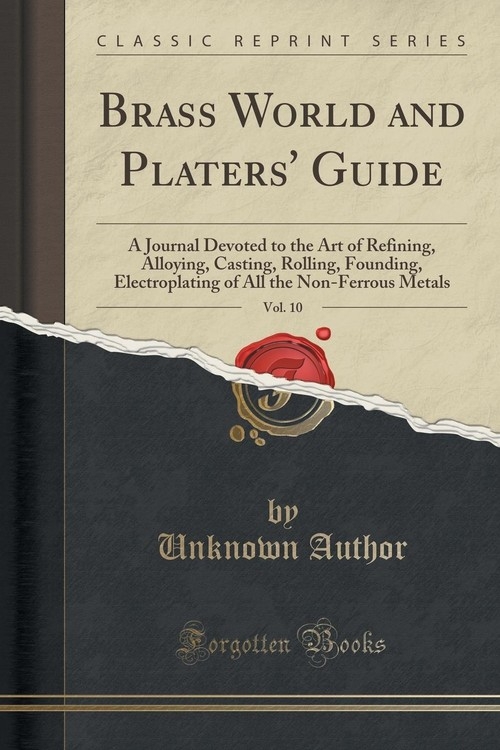Brass World and Platers' Guide, Vol. 10 A Journal Devoted to the Art of Refining, Alloying, Casting, Rolling, Founding, Electroplating of All the Non-Ferrous Metals (Classic Reprint)
Author Unknown
Brass World and Platers' Guide, Vol. 10
A Journal Devoted to the Art of Refining, Alloying, Casting, Rolling, Founding, Electroplating of All the Non-Ferrous Metals (Classic Reprint)
Author Unknown
- Wydawnictwo: FB &c Ltd
- EAN: 9781331939252
- Ilość stron: 528
- Format: 15.2x22.9cm
- Oprawa: Miękka
Niedostępna
Opis: Brass World and Platers' Guide, Vol. 10 - Author Unknown
Excerpt from Brass World and Platers' Guide, Vol. 10: A Journal Devoted to the Art of Refining, Alloying, Casting, Rolling, Founding, Electroplating of All the Non-Ferrous Metals
Gilding is a gold-colored mixture of copper and zinc and consists of 90% of copper and 10% of zinc. It has a gold color, although not as rich as pure gold or its alloys, of course. It is used when an imitation of gold is required and there are many instances in which it employed such as, for example, in the manufacture of cheap jewelry.
Bronze is a gilding mixture with the addition of a little tin and the favorite mixture is 90% copper, 9% zinc and 1% tin. For the majority of purposes, however, the straight gilding answers equally as well and is generally employed. A number of other mixtures of bronze are used, of course, depending upon the use to which they are to be put. Ordinary bronze for rolling, however, is the mixture previously given.
Use of Silver Cyanide in Making Silver Plating Solutions.
Silver cyanide is now used very extensively for making up silver plating solutions, even more so than formerly, as the majority of silver platers are beginning to appreciate its advantages. The use, therefore, can be said to be increasing.
There are three silver compounds that are being employed in making a silver plating solution in conjunction with potassium or sodium cyanide.
1. Silver nitrate.
2. Silver chloride.
3. Silver cyanide.
The use of silver nitrate has almost become obsolete although there are a few platers who still use it and obtain good results. It was the first silver salt used that was recommended. Its objection lies in the fact that, when dissolved in cyanide, sodium or potassium nitrate is formed by the reaction which fills the solution with an inert compound. This however, is apparently not directly objectionable as it appears to have no deleterious effect, contrary to the usual opinion, upon the deposit. The real disadvantage is in filling the plating solution with the sodium potassium nitrate which acts as so much foreign matter.
As far as the silver chloride is concerned, this is still quite extensively used and by some of the largest manufacturers of silver plated ware. One of the largest, if not the largest has always used it and still employs it. Their work is of the highest grade. The objection to it, however, is that it fills the solution with inert sodium or potassium chlorides when it is dissolved in cyanide. The reason why it has been and is still used, is that it is much easier to make than the silver cyanide. Any solution that contains silver and is acid or neutral in reaction may be precipitated by the addition of common salt or hydrochloric acid and an excess of these precipitants will not redissolve the silver chloride formed. It may be understood, therefore, that silver chloride is the easiest silver compound to prepare. This is particularly true in the case of the large silverware concerns which have stripping solutions, etc., to which it is only necessary to add salt or hydrochloric acid to form the chloride of silver, and it is so easy to make it is not surprising that it was early used as the silver salt for making up a silver plating solution.
The advantage of the silver cyanide lies in the fact that, when dissolved in cyanide no inert salt is formed but the double cyanide of potassium or sodium and silver is produced. This gives an ideal solution for silver plating and one which is theoretically correct. The solution may show a lower specific gravity than other solutions made from the chloride or the nitrate and still have more silver in it. This fact means that the solution will remain in good condition longer than the other solutions and will stand "building up" better.
The objection to the use of the silver cyanide has been one of making it. To produce the salt a neutral solution of silver nitrate is required and to it is adde
Szczegóły: Brass World and Platers' Guide, Vol. 10 - Author Unknown
Nazwa: Brass World and Platers' Guide, Vol. 10 A Journal Devoted to the Art of Refining, Alloying, Casting, Rolling, Founding, Electroplating of All the Non-Ferrous Metals (Classic Reprint)
Autor: Author Unknown
Wydawnictwo: FB &c Ltd
Kod paskowy: 9781331939252
Języki: angielski
Ilość stron: 528
Format: 15.2x22.9cm
Oprawa: Miękka



















